Many beginning astronomers start with computerised telescopes since they offer many advantages, like requiring less (but, contrary to popular belief, not zero) knowledge about the night sky to find objects, hands-free automatic tracking, and the ability to move the telescope with a button, which induces fewer vibrations than manual pushing.
Why do we often recommend Manual over GoTo Telescopes?
Computerised telescopes are not for everyone. They require constant power, usually a 12-volt portable power supply (basically a car battery) or lithium-ion battery packs. You usually can’t move them at all manually without ruining the alignment; we’ll get back to this later.
Furthermore, GoTo is not an exceptionally modern technology; it has been around for three and a half decades now. Your typical computerised telescope has an interface basically the same as it had 20 years ago, with a small hand controller with the processing abilities of a pocket calculator, a small LCD screen with calculator-like text, and many functional limitations. Most computerised scopes have no internal clocks and require realignment if power is lost, even briefly.
Most, or even the best computerised GoTo scopes, require a two-star alignment. It’s an advertised feature that supposedly lets you align on any three objects, or by pointing the scope north and levelling it. Neither works accurately, and you end up having to align with two known stars most of the time, meaning you need to have a basic understanding of the motions of the sky and some bright stars to find in it. And there are occasional failures and weird behaviours requiring hours of troubleshooting—hours that could be spent at the eyepiece instead.
Star charts and observing books like Turn Left At Orion are much more interesting and engaging to read than the user manual of a Go-To telescope, and learning star hops in online forums is more interesting and engaging than consulting troubleshooting forums.
And it is indeed more fun to manually point a telescope, following star-hops to figure out where an object is in the sky. It’s more fun because it’s more engaging and gives you something to do. By learning to find objects, you’re learning about the night sky. You’re learning to navigate it, to go from place to place, and to learn which objects are in the neighbourhood.
A few cases where I can see the need for Go-To scopes are: Observatories and Star Parties, where you need to reliably find an object to show it off on schedule, and specific astronomical events like occultations, transits, and eclipses, where you need the tracking to keep you pointed at some obscure object so you don’t miss anything. And, of course, astrophotography. But in all of these use cases, they’re not strongly overlapping with the interests of the beginner astronomer.
This being said, the pros may outweigh the cons for you depending on your situation, and there’s absolutely no shame in owning a computerised instrument. So let’s get into our top picks for computerised telescopes.
Lowest Price : Sky-Watcher Skyhawk 1145P AZ-GO2 WiFi (Under £300)
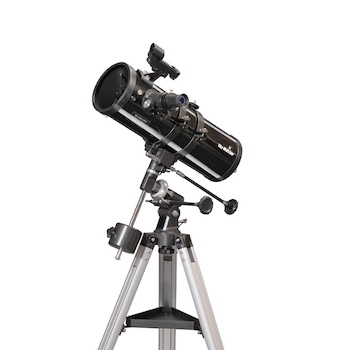
- Cheapest
- Sharp optics
- Wide field of view
- Decent supplied accessories/features
It’s certainly not the biggest or most well-equipped, but the Sky-Watcher Skyhawk 1145P AZ-GO2 is certainly a step up from many of the cheap GoTo systems available in its price range. What distinguishes this telescope from many of its predecessors and the competition is its wireless control capability, enabling users to harness the power of their smartphone or tablet to operate the telescope in place of a hand controller. This is achieved through the integration of the complimentary SynScan App, which is compatible with both iOS and Android platforms.
Possessing an admirable 114mm f/4.4 parabolic primary mirror, the Skyhawk 1145P can achieve a very wide field of view ideal for the largest deep-sky objects, and with an aftermarket Barlow lens or planetary eyepiece is excellent for sharp close-ups of the Moon, planets, and double stars. A 114mm telescope can’t quite resolve detail in galaxies or most globular star clusters, but it’s enough to get you started. A pair of eyepieces are supplied with the Skyhawk 1145P, but as mentioned you’ll definitely want more to explore the full range of magnifications
Best Budget : Sky-Watcher Heritage 150P Virtuoso GTi (£300-£500)
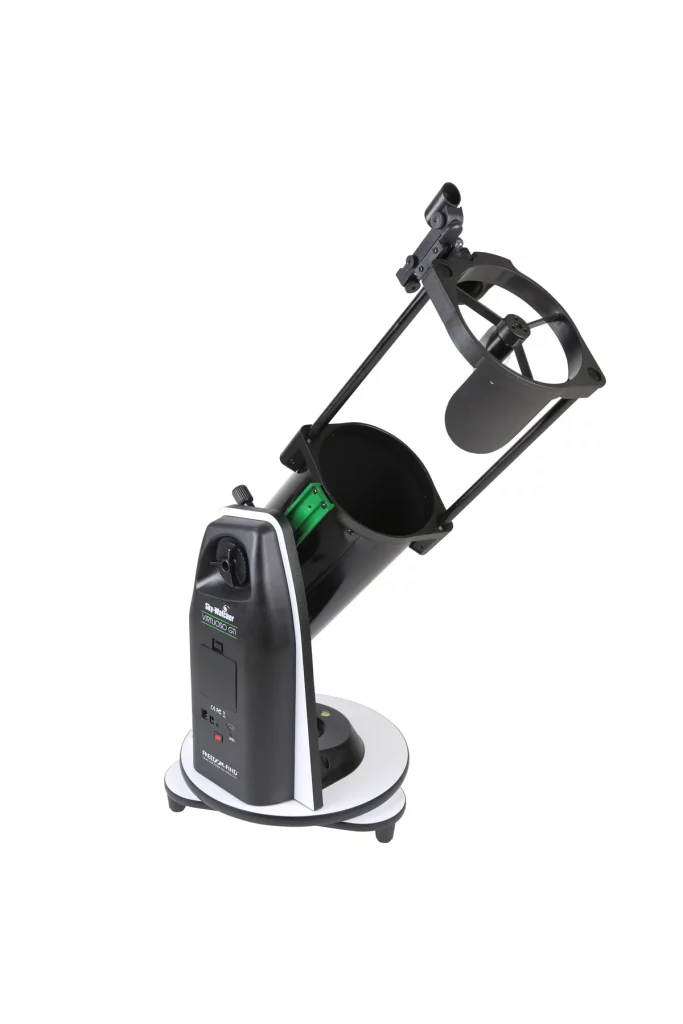
- Lightweight, compact, and quick to set up
- Large 6” aperture
- Very wide field of view
- Can be aimed manually or with SynScan app thanks to FreedomFind encoders
The Sky-Watcher GTi 150P is a formidable 6-inch (150mm) Newtonian reflector with full motorized GoTo and tracking at your fingertips, operate via your smartphone or tablet and the SkySafari Pro or the SynScan app. The 150P features FreedomFind encoders, which offer the flexibility to unlock the clutches for manual aiming, and this is feasible whether the electronics are powered up or not. This proves incredibly advantageous for a swift setup and as an alternative in case the battery is depleted.
The Virtuoso GTi 150P’s short 750mm focal length bestows upon it a substantially wider field of view as opposed to comparable 6-inch full-sized Dobsonian, refractor, or catadioptric telescopes. To ensure you are well-equipped, it includes two eyepieces along with a red dot finder, akin to what is found with Sky-Watcher’s other Virtuoso/Heritage tabletop telescopes. One of the remarkable facets of the Virtuoso GTi 150P is its portability. When disassembled, it can snugly fit into luggage or a sizable backpack. Optimal usage is achieved when placed atop a short, elevated surface such as a bar stool or a milk crate. Alternatively, a sturdy tripod with a 3/8-inch stud is also compatible. Given that the 150P is an open-tubed scope, it is advisable to fashion some form of shroud for the tube to curtail reflections. Moreover, investing in a higher-power eyepiece for planetary observation is recommended – though, it’s worth noting that additional purchases such as these are quite commonplace for almost any beginner scope.
Best w/Tripod : Celestron Astro Fi 6” SCT (£600-£800)
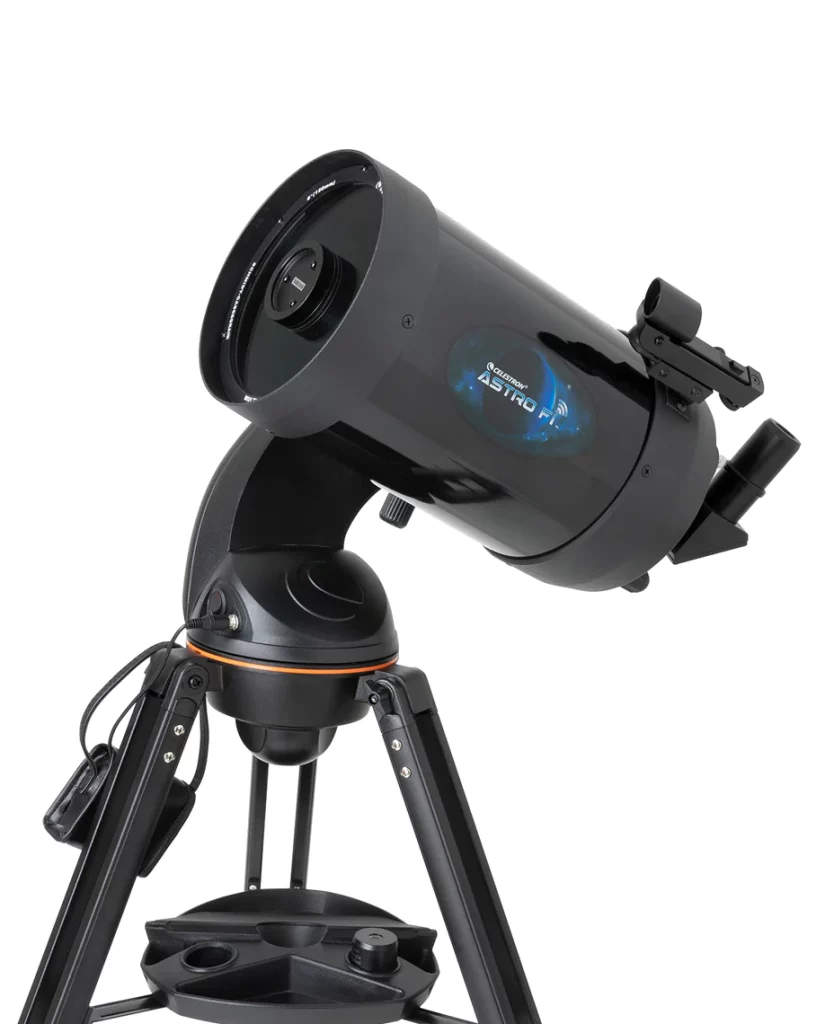
- Smooth, well-designed mount
- 2” focuser
- Easily adjusted for balance thanks to tube rings
The Celestron Astro Fi 6” SCT is an exquisite piece of astronomical equipment, exhibiting the sleek form factor of a compact, computerised Schmidt-Cassegrain telescope. Possessing sharp 6-inch f/10 optics, it crafts an exceptional experience for observers. It is, however, essential to note that when compared to a typical Newtonian/Dobsonian of similar aperture, the Astro Fi 6” SCT does not manage to achieve as wide a field of view thanks to its 1500mm focal length and lack of 2” accessory compatibility. Additionally, it doesn’t quite match the light-collecting prowess of the larger 8-inch and 10-inch Dobsonians available within the same price bracket. Despite this, the Celestron Astro Fi 6” SCT shines when it comes to observing the Moon, planets, double stars, and a plethora of the smaller and most luminous deep-sky objects. A pair of 1.25” eyepieces of decent quality are included with the Astro Fi 6” SCT to get you started, though you’ll be sure to want more to complement them as you get more experienced.
£800-£1000 Range : Sky-Watcher Skyliner 200P FlexTube GoTo
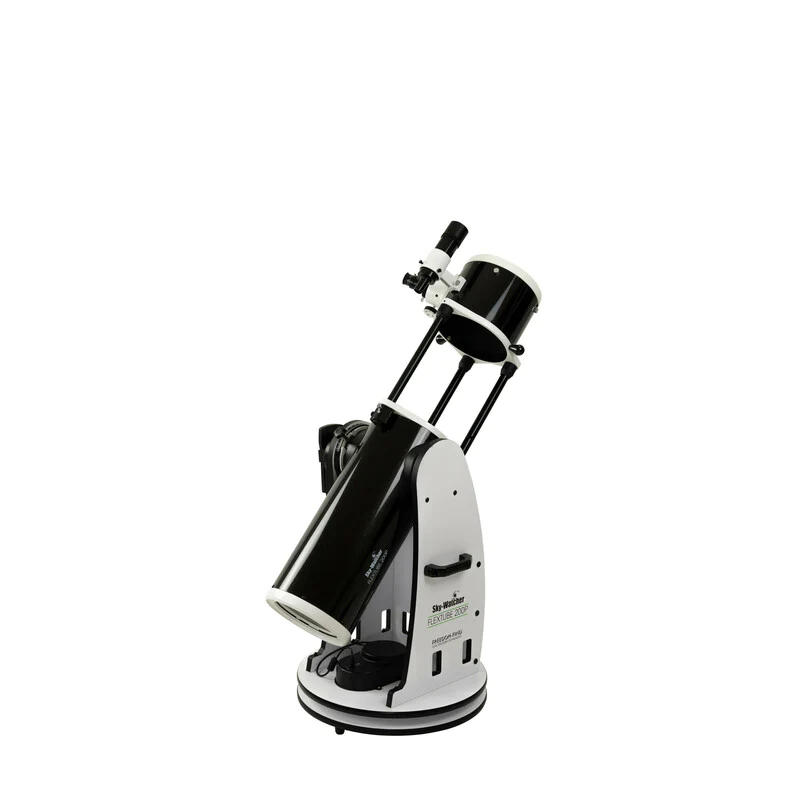
- 8” of aperture significantly improves deep-sky, lunar, and planetary details compared to a 6” or smaller instrument
- No tripod or stand to worry about at this size
- Can be aimed manually or with GoTo handset/app thanks to FreedomFind encoders
The Sky-Watcher Skyliner 200P FlexTube GoTo Dobsonian is in many ways much like a scaled-up Virtuoso GTi 150P. Like the GTi, the Skyliner 200P FlexTube GoTo Dobsonian features Sky-Watcher’s FreedomFind encoders, and depending on the version you get it is usually integrated with WiFi operability via the SynScan app (or with a SynScan hand controller if you wish). The 200P FlexTube largely puts up the same views as any other good 8” Dobsonian; the collapsible tube makes little difference at this size (though an aftermarket or DIY shroud is a good idea as with the other FlexTube Dobsonians). You also get a basic accessory set – 2 eyepieces and a finder scope – to get you on your way.
Best Value : Sky-Watcher Skyliner 250P FlexTube GoTo (£1000-£1500)
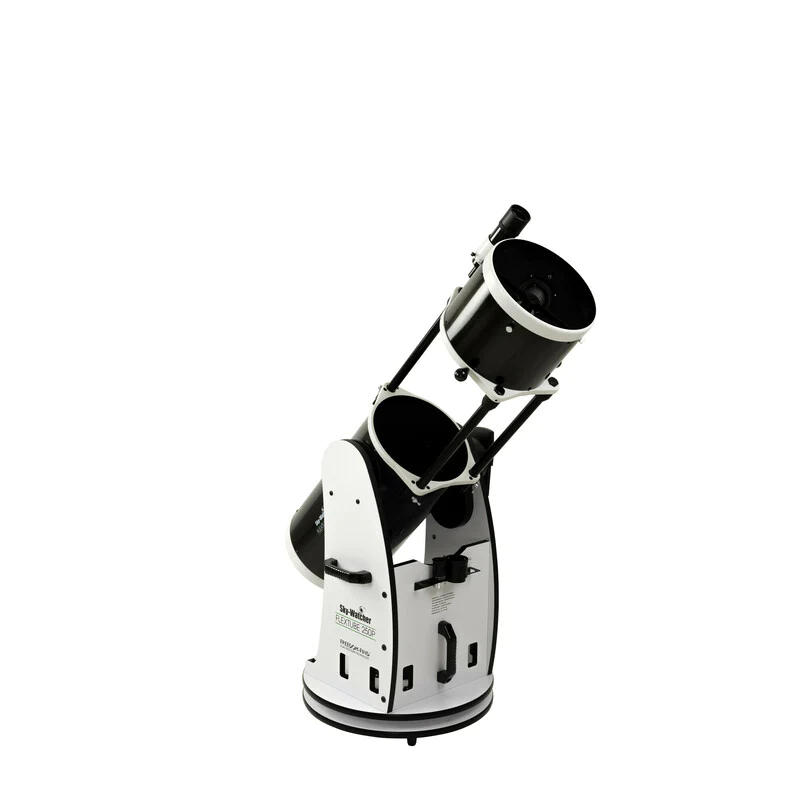
- Excellent views with 10” of aperture with few portability downsides compared to an 8”
- Easy to pick up and transport even fully assembled
- Can be aimed manually or with GoTo handset/app thanks to FreedomFind encoders
The Sky-Watcher Skyliner 250P FlexTube GoTo Dobsonian is actually shorter in length when collapsed than its 8” counterpart, and its base is largely the same physical size. The FlexTube design results in some slight portability improvements over a solid-tubed scope at this size, while the FreedomFind encoders and the ease of use of the 250P’s GoTo system of course make it an excellent buy.
Given the price, portability and similar handling characteristics to the 200P, we would strongly recommend you go with the Skyliner 250P FlexTube GoTo Dobsonian over the smaller 200P GoTo – viewing performance is significantly improved by the 250P’s larger aperture, and there are few to no drawbacks otherwise. The larger 300P is a significant step up in weight and heft, however.
£1500-£2000 Range : Sky-Watcher Skyliner 300P FlexTube GoTo
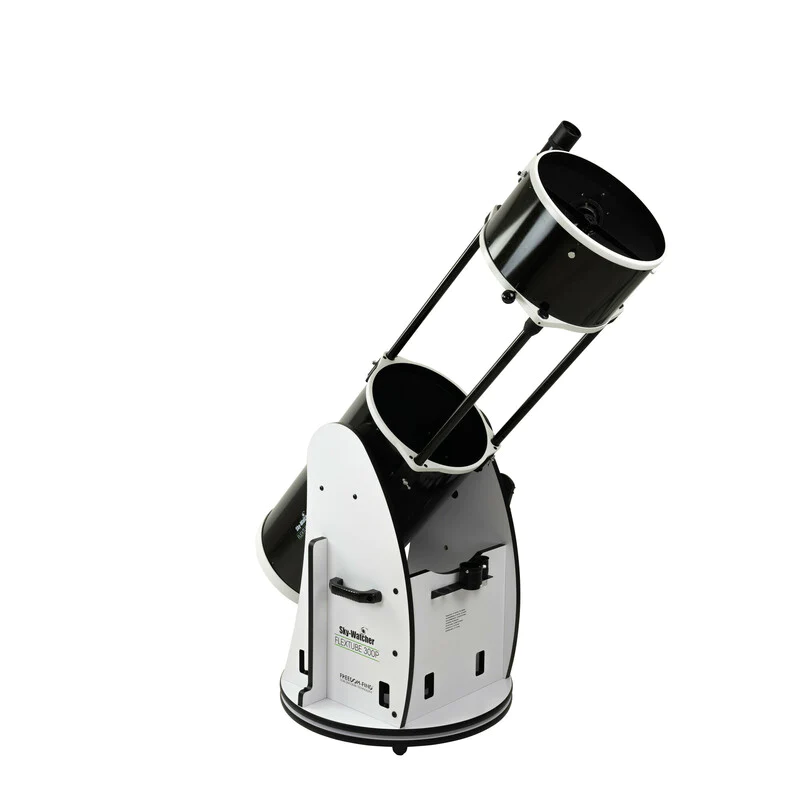
- 12” aperture blows away smaller instruments in viewing quality
- Fairly easy to transport yourself
- Can be aimed manually or with GoTo handset/app thanks to FreedomFind encoders
The Sky-Watcher Skyliner 300P FlexTube GoTo Dobsonian is an extraordinary beast. This telescope features plenty of light-gathering capacity, and astoundingly, it manages to maintain a modicum of portability too. Thanks to Sky-Watcher’s innovative FlexTube technology, the setup and relocation process is still streamlined to the extent that it can be managed single-handedly. This combination of potency and portability makes the Skyliner 300P a tour de force in the realm of amateur astronomy. The motorized base of the FlexTube 300P GoTo is, however, quite heavy and you might need help – or wheels – to move it around at all, as well as load it into a vehicle. As with the smaller FlexTube scopes, you get the same features like WiFi operability, a single-speed 2” Crayford focuser, a 50mm finderscope and a pair of eyepieces to get you started bundled in too.
£2000-£2500 Range : Sky-Watcher FlexTube 350P SynScan GoTo Collapsible Dobsonian
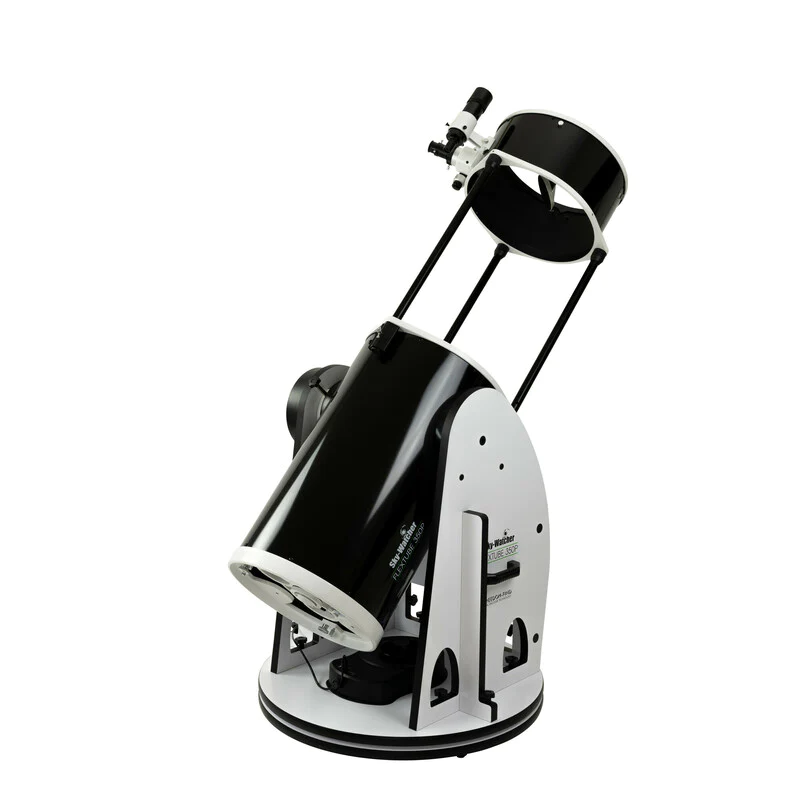
- 14” aperture for even brighter and bolder views, with motorized tracking and GoTo
- Base and tube both collapse for portability
- Dual-speed focuser
- Can be aimed manually or with GoTo handset/app thanks to FreedomFind encoders
The Sky-Watcher FlexTube 350P GoTo Dobsonian boasts a level of portability that, in certain respects, outdoes both the manual and GoTo versions of the FlexTube 300P. What’s the secret? The base effortlessly collapses into a flat configuration without the need for tools and can be reassembled within minutes. For those concerned with space during transportation, this feature is a godsend. Moreover, it is equipped with a first-rate dual-speed Crayford focuser, making fine adjustments a breeze even at high magnifications. Bear in mind, though, this is not a telescope for the casual observer. The FlexTube 350P demands considerable storage space and a sizeable vehicle for transport. However, the rewards are substantial, with a 36% increase in brightness compared to a 12-inch telescope.
Best Performance : Sky-Watcher FlexTube 400P SynScan GoTo Collapsible Dobsonian (£2500+)
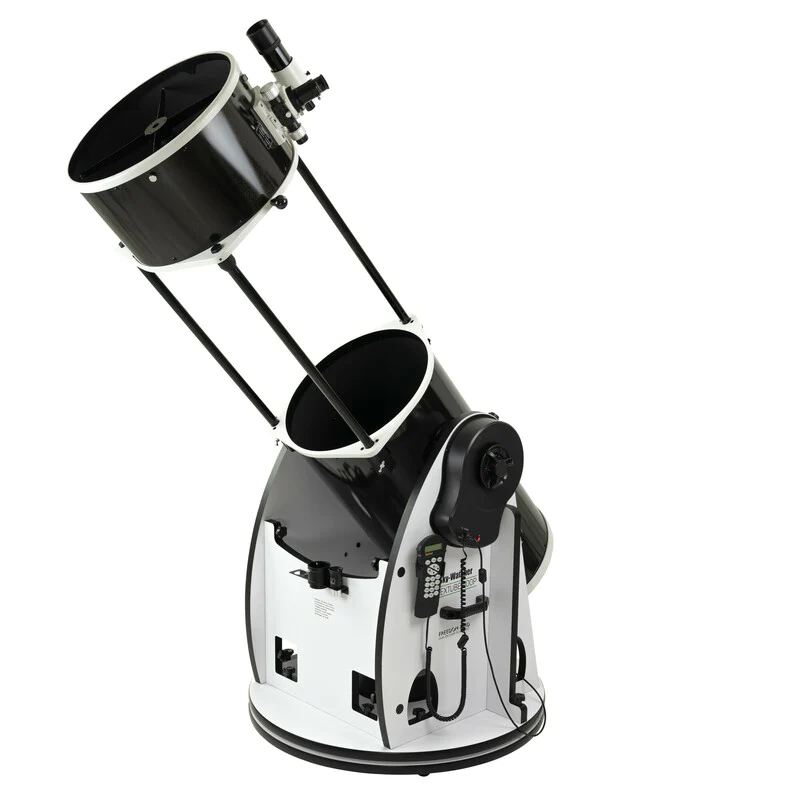
- 14” aperture for even brighter and bolder views, with motorized tracking and GoTo
- Base and tube both collapse for portability
- Dual-speed focuser
- Can be aimed manually or with GoTo handset/app thanks to FreedomFind encoders
The Sky-Watcher FlexTube 350P GoTo Dobsonian boasts a level of portability that, in certain respects, outdoes both the manual and GoTo versions of the FlexTube 300P. What’s the secret? The base effortlessly collapses into a flat configuration without the need for tools and can be reassembled within minutes. For those concerned with space during transportation, this feature is a godsend. Moreover, it is equipped with a first-rate dual-speed Crayford focuser, making fine adjustments a breeze even at high magnifications. Bear in mind, though, this is not a telescope for the casual observer. The FlexTube 350P demands considerable storage space and a sizeable vehicle for transport. However, the rewards are substantial, with a 36% increase in brightness compared to a 12-inch telescope.
Runner Ups
- Celestron Astro Fi 130
The Celestron Astro-Fi 130 boasts an aperture measuring 5.1 inches (130mm). This sizable aperture ensures that the telescope is capable of collecting ample light, which, in conjunction with its commendable field of view at 650mm focal length and the option of a 2” eyepiece, guarantees spectacular views of the Moon, planets, and deep-sky objects. The Astro-Fi 130’s light collecting and resolving power makes it a breeze to witness the enthralling shadow transits of Jupiter’s moons and to discern even the most luminescent globular star clusters, such as M13.
The Astro Fi 130 is controlled via your smartphone/tablet with the Celestron SkyPortal app or directly via SkySafari, either of which is significantly more intuitive than the Sky-Watcher SynScan app. Its included accessories and aluminium tripod are decent enough, but the larger 6” and 8” Dobsonian telescopes available with or without a computerised mount tend to be a better option for the same price.
- Celestron Astro Fi 127
The Celestron Astro Fi 127 is characterised by its 4.7-inch (120mm) Maksutov-Cassegrain optics, which deliver sharp and crisp views. It’s perched atop a full-sized tripod and offers the same modern controls as the Astro Fi 130 via a smartphone or tablet through the SkyPortal or SkySafari Pro apps. To ensure you hit the ground running, it comes bundled with a red dot finder, a 1.25-inch prism star diagonal, and a duo of eyepieces.
It’s worth mentioning, however, that due to the Astro-Fi 127’s smaller aperture and a lengthy 1500mm focal length, it’s somewhat limited in its prowess for observing deep-sky objects. For instance, the biggest and brightest nebulae and open star clusters won’t fit within the field of view, and the telescope’s aperture is too modest to observe planetary nebulae, globular clusters, and galaxies in great detail. Despite these limitations, the telescope’s compactness and portability, coupled with the fact that it doesn’t require collimation, make it a contender worth considering nonetheless.
- Sky-Watcher Virtuoso GTi 127
The Virtuoso GTi 127 uses the same optics as the Celestron Astro Fi 127, but with the Virtuoso GTi tabletop mount from Sky-Watcher. This mount is smartphone-controlled and allows for manual movements thanks to its FreedomFind encoders and slip clutch technology, but it does not include a tripod. You’ll have to purchase a tripod with a ⅜” stud separately if you do not want to use this scope on a table – or pick another option such as the AZ-GTi 127 or Astro Fi 127 instead.
- Sky-Watcher AZ-GTi 127
The Sky-Watcher AZ-GTi has the same optics and, by and large, the same features as the Virtuoso GTi 127, but is mounted atop the AZ-GTi mount and tripod. Not only does the AZ-GTi feature FreedomFind encoders and full smartphone-controlled GoTo, but it can also be converted to a tracker for long-exposure astrophotography with a telephoto lens with the Sky-Watcher Star Adventurer wedge. The AZ-GTi’s provided tripod also provides a lot more versatility than the Astro Fi 127 (which is significantly less compact) or the tabletop GTi 127.
- Celestron NexStar 6SE
The Celestron NexStar 6SE uses the same C6 XLT optical tube as the Celestron Astro Fi 6”, but is operated via a hand controller rather than a WiFi connection (though a WiFi dongle can be purchased as an aftermarket addition). While its mount/tripod is more stable than the Astro Fi, it’s not enough to be a selling point on its own when you consider the higher price and lack of WiFi functionality – at least not for most prospective buyers.
- Celestron NexStar Evolution 6
The 6-inch NexStar Evolution is an entrancing piece of astronomy equipment, featuring the renowned C6 XLT optical tube, which is identical to that of its kin, the NexStar 6SE and Astro Fi 6” SCT. The chief distinction lies in the mounting, as the 6-inch NexStar Evolution is elegantly situated atop the innovative Celestron NexStar Evolution mount, a beefy design adorned with built-in WiFi, and an integrated battery. It is pertinent to note that, barring these slight variations, the core telescope remains unaltered. The upgrades certainly add a layer of convenience, but at a steeper price. Those who are more cost-conscious may find it more worthwhile to simply purchase a lithium battery as an add-on to a NexStar 6SE or Astro Fi 6” SCT instead.
- Celestron NexStar Evolution 8
The Celestron NexStar Evolution 8 boasts a whopping 8-inch (203mm) aperture housed in Celestron’s compact yet versatile C8 XLT optical tube, which has garnered accolades for its design since the 1970s. This f/10 Schmidt-Cassegrain telescope possesses an impressive focal length of 2032mm. The NexStar Evolution mount and accompanying tripod are armed with a sophisticated GoTo system that can be effortlessly controlled via the provided hand controller, or alternatively through a smartphone app such as SkySafari or Celestron’s own SkyPortal app. A salient feature is the ability to unlock the mount’s clutches to manually aim the telescope. However, it’s crucial to remember that this functionality is unavailable when the telescope is powered on. The built-in WiFi is certainly a crowning feature, and it is further complemented by an in-built rechargeable lithium battery that promises longevity, capable of powering the scope for several nights and lasting roughly a decade before necessitating replacement.
Tips on Choosing the Best Computerised Telescope
- Power
Except for the Celestron NexStar Evolution telescopes, almost every computerised telescope requires a portable power supply, either a 12-volt lead-acid rechargeable DC battery or lithium-ion rechargeable batteries. Either adds cost to your scope and has to be hauled around. Some telescopes can use AA batteries as backups, but they will quickly guzzle them within a few observing sessions, and continually replenishing them is expensive. So, always budget at least £50 for a power supply.
- You Get What You Pay For
Cheaper computerised telescopes have weaker tripods and plastic or imprecise gears, and tend to consume more power. They’re also typically smaller and include lower-quality or fewer accessories.
- Aperture
More aperture means more light-collecting area, which allows you to see fainter objects more easily. Light-gathering ability goes up with the square of the aperture, so an 8” telescope gathers four times as much light as a 4” telescope.
Aperture also increases resolution, which in turn increases the maximum magnification usable with a given telescope. Resolution increases linearly with diameter, so an 8” telescope has twice the resolution of a 4” telescope.
- Magnification
On a night of good seeing, a telescope can be used at as much as 40–50x per inch of aperture. However, more power doesn’t show you more things, and most planetary/lunar observers use around 30x/inch for observations. For deep-sky observing, particularly for large objects and to find things in the sky, use as little power as possible.
